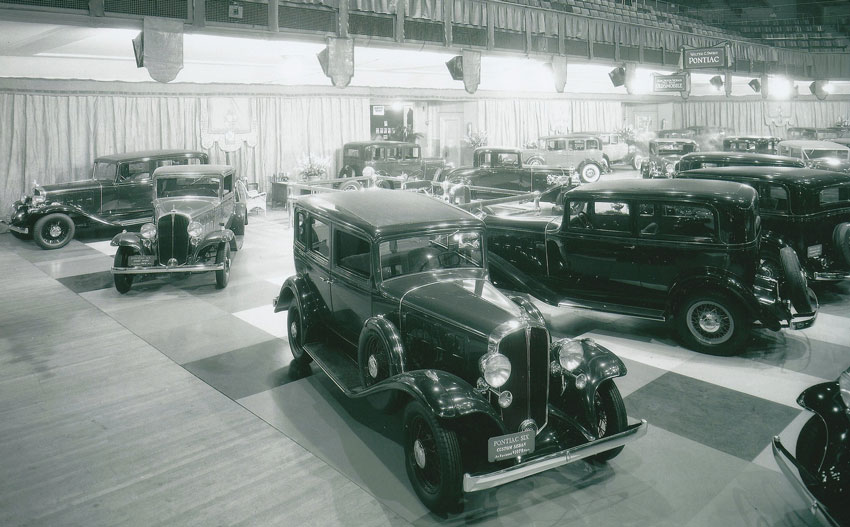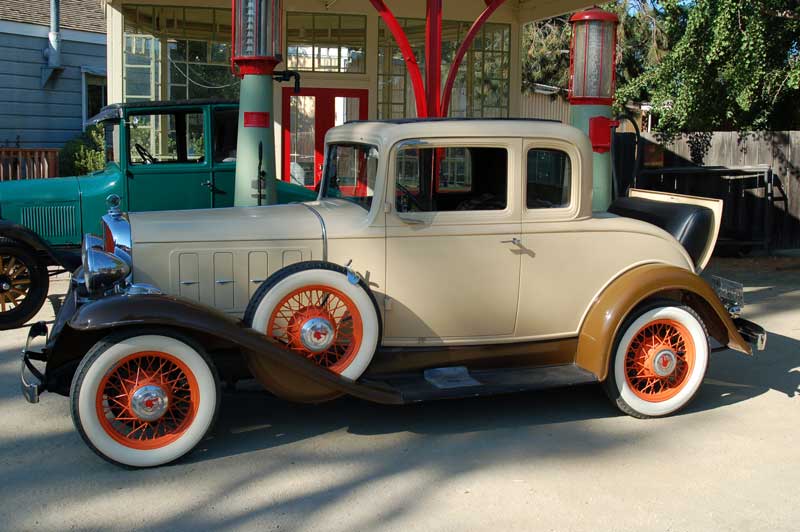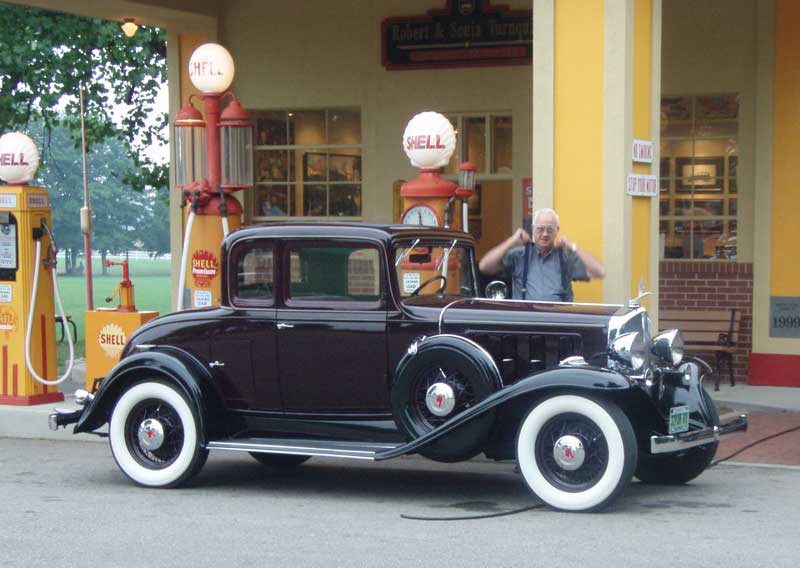
Pontiac for 1932, “Chief of Values”
The economic depression that followed the stock market crash of 1929 “peaked” for the automobile industry with the 1932 model year; overall production was less than 30% of what it had been in the year of the crash. Pontiac, the first of the “companion” cars introduced by General Motors, became the only product line of the Oakland Motor Car Company. Oakland sales had been suffering and the decision was made to end production at the end of 1931. In June of ’32, the Oakland Motor Car Company became the Pontiac Motor Company.
Pontiac offered 2 distinct model lines for the first time ever in 1932, the Series 302 Eight and the Series 402 Six. In reality, the Series 302 Eight models were essentially restyled 1931 Oakland Series 301 automobiles bearing the Pontiac nameplate. The Series 402 Six featured the same models as they had the previous year, but the bodies and chassis were new. There were 6 models in either series; a 2 door, 2 passenger coupe; the sport coupe and convertible coupe, both of which offered a rumble seat for 2 extra passengers; the 3 remaining models were all 5 passenger sedans, a 2 door, a 4 door and a 4 door Custom Sedan.
New styling eliminated the exterior sun-visor and raked the windshield back at a 10 degree angle. The vee-shaped radiator featured vertical, chrome-plated grille bars, its impressive styling clearly visible due to the elimination of the headlight tie-bar. The headlamp assemblies were chrome and individually mounted through the fenders to the braces below, dual trumpet-style chrome horns, carried just under the lamps, were standard on all but the basic coupe, (6 or 8) and the Six 2 or 4 door sedans. The radiator cap identified the engine installed; the Six got an Indian-head within a circle while the Eight feature a graceful “bird in flight” ornament. The hood panels were fitted with 4 ventilating doors on each side as opposed to louvers, the hood hinge, side panel handles and vent door handles were all chrome plated. Front fenders were deeply crowned, with parking lamps mounted on top. Six-wheel equipment was optionally available with side-mounted spare tires. The combination stop and tail light was chrome-plated, dual tail lamps were fitted to the same models that got two horns. The closed Fisher bodies were fitted with their patented Vision-Ventilation windshield, and new this year was the installation of a cowl ventilator that admitted air onto the floorboard.
There were 16 color combinations and the paint work was intricate. In addition to the main body color, the window reveals and body moldings were painted, the bodywork was also striped and more often than not, in 2 colors. The majority of models used mohair upholstery; the Custom Sedan was also available with whipcord fabric while the Convertible Coupe was fitted with Spanish Leather. The sedans featured rear arm and foot rests, roller window shades, dome lamp and a smoking set. The Custom Sedan added a center rear seat arm rest and the lap robe cord and assist straps were silk-covered. The Sport Coupe rear window opened to allow communication with the rumble seat passengers, the same was true for the Convertible Coupe. The windshield on the Convertible could also be folded flat for truly “open-air” motoring.
The Six chassis rode on a 114 inch wheelbase, up 2 inches from 1931. The Eight’s remained at 117”, a carry-over from the Oakland; both frames added a 6th cross member for increased rigidity. Bendix brakes were fitted to all models; they were self-energizing by design, with 12” drums on the Six and 13” on the Eight. Kelsey-Hayes wire wheels were standard equipment; wooden artillery wheels were optional at extra cost. The wheels were slightly smaller than those offered in 1931, but mounted larger tires for improved ride and handling characteristics. A Muncie 3 speed transmission was used, new for Pontiac this year was “Synchromesh” on second and high gear. All models were also fitted with “Free Wheeling”; the control knob was mounted just to the right of the steering column. Free Wheeling was offered on many automobiles during this time. It consisted of an over-running clutch in its own housing at the back of the transmission. When in operation, this clutch would transmit power from the engine, through the transmission and on to the rear axle, but would “free-wheel” if the accelerator was released and no engine braking would be provided. Since the motion of the car was not “back-driving” the engine or transmission, the driver could shift any of the forward gears without using the clutch pedal. The vehicle would drive in a conventional manner when Free Wheeling unit was turned off. Obviously, “free-wheeling” needed to be used carefully by the driver. The complete lack of engine braking could be disastrous if the unit was in operation as the driver began to descend a steep downgrade. Most states now have laws making it illegal to “coast in neutral”; presumably at least some of these were enacted as a result of “free-wheeling” accidents. Used judiciously, Free Wheeling could improve your fuel economy, but at the penalty of increased wear on the vehicle’s braking system.
The economic depression that followed the stock market crash of 1929 “peaked” for the automobile industry with the 1932 model year; overall production was less than 30% of what it had been in the year of the crash. Pontiac, the first of the “companion” cars introduced by General Motors, became the only product line of the Oakland Motor Car Company. Oakland sales had been suffering and the decision was made to end production at the end of 1931. In June of ’32, the Oakland Motor Car Company became the Pontiac Motor Company.
Pontiac offered 2 distinct model lines for the first time ever in 1932, the Series 302 Eight and the Series 402 Six. In reality, the Series 302 Eight models were essentially restyled 1931 Oakland Series 301 automobiles bearing the Pontiac nameplate. The Series 402 Six featured the same models as they had the previous year, but the bodies and chassis were new. There were 6 models in either series; a 2 door, 2 passenger coupe; the sport coupe and convertible coupe, both of which offered a rumble seat for 2 extra passengers; the 3 remaining models were all 5 passenger sedans, a 2 door, a 4 door and a 4 door Custom Sedan.
New styling eliminated the exterior sun-visor and raked the windshield back at a 10 degree angle. The vee-shaped radiator featured vertical, chrome-plated grille bars, its impressive styling clearly visible due to the elimination of the headlight tie-bar. The headlamp assemblies were chrome and individually mounted through the fenders to the braces below, dual trumpet-style chrome horns, carried just under the lamps, were standard on all but the basic coupe, (6 or 8) and the Six 2 or 4 door sedans. The radiator cap identified the engine installed; the Six got an Indian-head within a circle while the Eight feature a graceful “bird in flight” ornament. The hood panels were fitted with 4 ventilating doors on each side as opposed to louvers, the hood hinge, side panel handles and vent door handles were all chrome plated. Front fenders were deeply crowned, with parking lamps mounted on top. Six-wheel equipment was optionally available with side-mounted spare tires. The combination stop and tail light was chrome-plated, dual tail lamps were fitted to the same models that got two horns. The closed Fisher bodies were fitted with their patented Vision-Ventilation windshield, and new this year was the installation of a cowl ventilator that admitted air onto the floorboard.
There were 16 color combinations and the paint work was intricate. In addition to the main body color, the window reveals and body moldings were painted, the bodywork was also striped and more often than not, in 2 colors. The majority of models used mohair upholstery; the Custom Sedan was also available with whipcord fabric while the Convertible Coupe was fitted with Spanish Leather. The sedans featured rear arm and foot rests, roller window shades, dome lamp and a smoking set. The Custom Sedan added a center rear seat arm rest and the lap robe cord and assist straps were silk-covered. The Sport Coupe rear window opened to allow communication with the rumble seat passengers, the same was true for the Convertible Coupe. The windshield on the Convertible could also be folded flat for truly “open-air” motoring.
The Six chassis rode on a 114 inch wheelbase, up 2 inches from 1931. The Eight’s remained at 117”, a carry-over from the Oakland; both frames added a 6th cross member for increased rigidity. Bendix brakes were fitted to all models; they were self-energizing by design, with 12” drums on the Six and 13” on the Eight. Kelsey-Hayes wire wheels were standard equipment; wooden artillery wheels were optional at extra cost. The wheels were slightly smaller than those offered in 1931, but mounted larger tires for improved ride and handling characteristics. A Muncie 3 speed transmission was used, new for Pontiac this year was “Synchromesh” on second and high gear. All models were also fitted with “Free Wheeling”; the control knob was mounted just to the right of the steering column. Free Wheeling was offered on many automobiles during this time. It consisted of an over-running clutch in its own housing at the back of the transmission. When in operation, this clutch would transmit power from the engine, through the transmission and on to the rear axle, but would “free-wheel” if the accelerator was released and no engine braking would be provided. Since the motion of the car was not “back-driving” the engine or transmission, the driver could shift any of the forward gears without using the clutch pedal. The vehicle would drive in a conventional manner when Free Wheeling unit was turned off. Obviously, “free-wheeling” needed to be used carefully by the driver. The complete lack of engine braking could be disastrous if the unit was in operation as the driver began to descend a steep downgrade. Most states now have laws making it illegal to “coast in neutral”; presumably at least some of these were enacted as a result of “free-wheeling” accidents. Used judiciously, Free Wheeling could improve your fuel economy, but at the penalty of increased wear on the vehicle’s braking system.
“Ride Control” shock absorbers were another new feature for 1932. The shock absorbers were driver adjustable, even while the car was in motion, and controlled by a knob on the dashboard just to the left of the steering wheel. The knob changed the rate at which oil trapped within the shock cylinder was allowed to escape, thereby adjusting its action from “stiff” with a minimal valve opening, to “soft” when the valve was fully open. Fast travel on rough roads required the “stiff” or closed setting, while smooth roads could be traversed with the Ride Control at the “open” setting. Travel on rough roads at low speed could be done at the “open” setting, as well. The driver was instructed to find the position that suited their particular type of driving, usually in the middle range of adjustment. They were also advised to adjust the shocks depending upon the load being carried in the back seat.
“Ride Control” is unique to 1932, the idea was a good one, especially considering the wide variety of roads in existence at that time; I think it is safe to assume that the majority of drivers did not want another control that required their frequent attention. The trend toward less driver input was already underway, especially for functions that, improperly managed, could be detrimental to the durability of the automobile. Manual control of the spark timing and fuel mixture, once common, was now all but obsolete. Oldsmobile and Packard debuted automatic choke carburetors in ’32; Pontiac made them standard in 1935 on the Eights and 1936 on the Sixes, than removed the hand throttle from the dashboard in 1942. Carburetor heat control was rapidly coming under thermostatic control as well. Automatic control of important functions eliminated the need for training the driver to manage the systems properly. The automobile industry was about putting America on wheels, simple operation was a necessity toward achieving maximum acceptance of the product.
Pontiac made significant improvements in the six cylinder engine for 1932. The crankshaft was redesigned and its weight increased to 61 pounds, the harmonic balancer was improved, plus new steel-backed bearing were fitted to the crank and camshaft. The connecting rods were rifle-drilled for full pressure lubrication of the piston pins and the water inlet from the radiator was positioned between cylinders 3 and 4 to improve the distribution of coolant within the engine. A new 3 jet updraft Marvel carburetor was installed; this unit included an accelerator pump and automatic “economizer” functioning on the intermediate and high speed jets up to 50mph. The mixture heat control was directly operated by a link with the throttle, providing less heat as the engine speed increased, it also had 3 seasonal settings for the driver to select; Summer, Medium and Winter. These improvements resulted in a 5 horsepower increase from the previous year; the engine was now rated for 65hp @ 3,200rpm.
The Pontiac V-8 displacement remained at 251 cubic inches, the same as it had been for the Oakland. The horsepower rating was 85 @ 3,200rpm and the compression ratio was 5.2:1. The most notable change in the engine for 1932 was the “synchronizer” link was on the opposite side from the Oakland engine. This engine used a “flat” crankshaft; that is to say that the connecting rod throws were 180 degrees apart, like a 4 cylinder engine. The “flat” crankshaft was cheaper to produce; more expensive designs utilize a crankshaft with throws spaced at 90 degrees. The significant difference is balance; a flat crankshaft imposes a secondary vibration that rocks the engine from side to side, to overcome this problem, Oakland engineers fitted a “synchronizer” link. This link was mounted between the vehicle frame and a moving point inside the engine, driven at one-half crankshaft speed by the timing chain; it opposed the natural tendency of the engine to “rock” in its mounts. The inherent imbalance problem and relatively high production costs of the V-8 were known to Oakland and G.M. management prior to 1932, and work was already underway on its replacement.
The option list for ’32 was relatively basic; radio, heater, spare tire cover(s) and dual side-mounted spare tires were available. Vehicles with six-wheel equipment could be fitted with a rear luggage rack and a touring trunk was also listed.
According to Pontiac parts information, there were standard and high compression cylinders heads available for both the Six and V-8 engines beginning in 1932. I do not have any additional information about these optional cylinder heads at this time, other than the assigned part numbers.
Production numbers for 1932 were the lowest ever recorded, there were 39,059 Pontiac Six and just 6,281 Pontiac V-Eight units, for a total model year output of 45,340 automobiles.
Thank you to Rob Guzetta and Reid Williamson for their help with the article this month.
“Ride Control” is unique to 1932, the idea was a good one, especially considering the wide variety of roads in existence at that time; I think it is safe to assume that the majority of drivers did not want another control that required their frequent attention. The trend toward less driver input was already underway, especially for functions that, improperly managed, could be detrimental to the durability of the automobile. Manual control of the spark timing and fuel mixture, once common, was now all but obsolete. Oldsmobile and Packard debuted automatic choke carburetors in ’32; Pontiac made them standard in 1935 on the Eights and 1936 on the Sixes, than removed the hand throttle from the dashboard in 1942. Carburetor heat control was rapidly coming under thermostatic control as well. Automatic control of important functions eliminated the need for training the driver to manage the systems properly. The automobile industry was about putting America on wheels, simple operation was a necessity toward achieving maximum acceptance of the product.
Pontiac made significant improvements in the six cylinder engine for 1932. The crankshaft was redesigned and its weight increased to 61 pounds, the harmonic balancer was improved, plus new steel-backed bearing were fitted to the crank and camshaft. The connecting rods were rifle-drilled for full pressure lubrication of the piston pins and the water inlet from the radiator was positioned between cylinders 3 and 4 to improve the distribution of coolant within the engine. A new 3 jet updraft Marvel carburetor was installed; this unit included an accelerator pump and automatic “economizer” functioning on the intermediate and high speed jets up to 50mph. The mixture heat control was directly operated by a link with the throttle, providing less heat as the engine speed increased, it also had 3 seasonal settings for the driver to select; Summer, Medium and Winter. These improvements resulted in a 5 horsepower increase from the previous year; the engine was now rated for 65hp @ 3,200rpm.
The Pontiac V-8 displacement remained at 251 cubic inches, the same as it had been for the Oakland. The horsepower rating was 85 @ 3,200rpm and the compression ratio was 5.2:1. The most notable change in the engine for 1932 was the “synchronizer” link was on the opposite side from the Oakland engine. This engine used a “flat” crankshaft; that is to say that the connecting rod throws were 180 degrees apart, like a 4 cylinder engine. The “flat” crankshaft was cheaper to produce; more expensive designs utilize a crankshaft with throws spaced at 90 degrees. The significant difference is balance; a flat crankshaft imposes a secondary vibration that rocks the engine from side to side, to overcome this problem, Oakland engineers fitted a “synchronizer” link. This link was mounted between the vehicle frame and a moving point inside the engine, driven at one-half crankshaft speed by the timing chain; it opposed the natural tendency of the engine to “rock” in its mounts. The inherent imbalance problem and relatively high production costs of the V-8 were known to Oakland and G.M. management prior to 1932, and work was already underway on its replacement.
The option list for ’32 was relatively basic; radio, heater, spare tire cover(s) and dual side-mounted spare tires were available. Vehicles with six-wheel equipment could be fitted with a rear luggage rack and a touring trunk was also listed.
According to Pontiac parts information, there were standard and high compression cylinders heads available for both the Six and V-8 engines beginning in 1932. I do not have any additional information about these optional cylinder heads at this time, other than the assigned part numbers.
Production numbers for 1932 were the lowest ever recorded, there were 39,059 Pontiac Six and just 6,281 Pontiac V-Eight units, for a total model year output of 45,340 automobiles.
Thank you to Rob Guzetta and Reid Williamson for their help with the article this month.

Magazine Ad Link(large file): It's spring get a Pontiac Brochure Model picture


